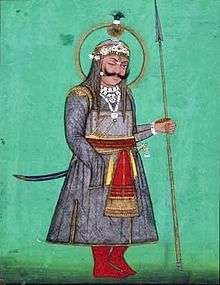Rana Sanga
| Maharana Sangram Singh | |||||
|---|---|---|---|---|---|
 Depiction of Maharana Sangram Singh. | |||||
| Rana of Mewar | |||||
| Reign | 1508–1528 | ||||
| Predecessor | Rana Raimal | ||||
| Successor | Ratan Singh II | ||||
| Born |
12 April 1482 Malwa, Delhi sultanate | ||||
| Died |
30 January 1528 (aged 43) Kalpi, Mughal empire | ||||
| Spouse | Rani Karnavati | ||||
| Issue |
Bhoj Raj Ratan Singh II Vikramaditya Singh Udai Singh II | ||||
| |||||
| House | Sisodia | ||||
| Father | Rana Raimal | ||||
| Sisodia Rajputs of Mewar II (1326–1884) | |
|---|---|
| Hammir Singh | (1326–1364) |
| Kshetra Singh | (1364–1382) |
| Lakha Singh | (1382–1421) |
| Mokal Singh | (1421–1433) |
| Rana Kumbha | (1433–1468) |
| Udai Singh I | (1468–1473) |
| Rana Raimal | (1473–1508) |
| Rana Sanga | (1508–1527) |
| Ratan Singh II | (1528–1531) |
| Vikramaditya Singh | (1531–1536) |
| Vanvir Singh | (1536–1540) |
| Udai Singh II | (1540–1572) |
| Pratap Singh I | (1572–1597) |
| Amar Singh I | (1597–1620) |
| Karan Singh II | (1620–1628) |
| Jagat Singh I | (1628–1652) |
| Raj Singh I | (1652–1680) |
| Jai Singh | (1680–1698) |
| Amar Singh II | (1698–1710) |
| Sangram Singh II | (1710–1734) |
| Jagat Singh II | (1734–1751) |
| Pratap Singh II | (1751–1754) |
| Raj Singh II | (1754–1762) |
| Ari Singh II | (1762–1772) |
| Hamir Singh II | (1772–1778) |
| Bhim Singh | (1778–1828) |
| Jawan Singh | (1828–1838) |
| Sardar Singh | (1828–1842) |
| Swarup Singh | (1842–1861) |
| Shambhu Singh | (1861–1874) |
| Sajjan Singh | (1874–1884) |
| Fateh Singh | (1884–1930) |
| Bhupal Singh | (1930—1955) |
Maharana Sangram Singh (12 April 1482 – 30 January 1528) commonly known as Rana Sanga, was an Indian ruler of Mewar and head of a powerful Hindu Rajput confederacy in Rajputana during the 16th century. He was of the Sisodiya clan of Rajput. Rana ruled between 1508 and 1528.[1]
Rana Sanga succeeded his father, Rana Raimal, as king of Mewar in 1508. He fought against the Afghan Lodhi dynasty of Delhi Sultanate, and later against the Mughals.
Life
Rana Sanga was a grandson of Rana Kumbha. Sanga became the ruler of Mewar after a battle for succession with his brothers.[2]
As ruler of Mewar he expanded the boundaries of his Kingdom. First taking the advantage of internal strife in the Delhi Sultanate, he expanded into North East Rajasthan after defeating Ibrahim Lodi in the Battles of Khatoli and Dholpur. Mewar attempted to vassalise Idar by reinstating Raimal onto the throne by defeating Bharmal who was supported by Gujarat. This led to a Mewar-Gujarat war and the Battles of Idar. He supposedly defeated the Gujarat Sultanate during Rana Sanga's invasion of Gujarat. Sangram Singh also defeated the joint forces of Gujarat and Malwa Sultanates in the Siege of Mandsaur and the Battle of Gagron.
Following the victory of Babur over the Lodhi Dynasty, Sangram Singh gathered a coalition of Rajputs from the kingdoms of Rajasthan. They were joined by Muslim Rajputs from Mewat and Afghans under Mahmud Lodhi, the son of Sikandar Lodhi of Delhi. This alliance fought against Babur in the Battle of Khanwa to restore the Lodhi Dynasty and expel Babur from India.
On 30 January 1528, Rana Sanga died in Chittor, apparently poisoned by his own chiefs who held his plans of renewing the fight with Babur to be suicidal.[3]
It is suggested that had there not been the cannons of Babur, then Rana Sanga might have achieved a historic victory against Babur.[4] The historian Pradeep Barua notes that Babur's cannons had put an end to the outdated trends in Indian warfare.[4]
See also
References
- ↑ Sen, Sailendra (2013). A Textbook of Medieval Indian History. Primus Books. pp. 116–117. ISBN 978-9-38060-734-4.
- ↑ Chandra, Satish (2004) [1997]. Medieval India: From Sultanat to the Mughals-Delhi Sultanat (1206-1526). 1 (Revised ed.). Har-Anand Publications. p. 224. ISBN 978-8-12411-064-5.
- ↑ Chandra, Satish (2006). Medieval India: From Sultanat to the Mughals (1206-1526). 2. Har-Anand Publications.
- 1 2 Barua, Pradeep (2005). The State at War in South Asia. University of Nebraska Press. pp. 33–34. ISBN 978-0-80321-344-9.